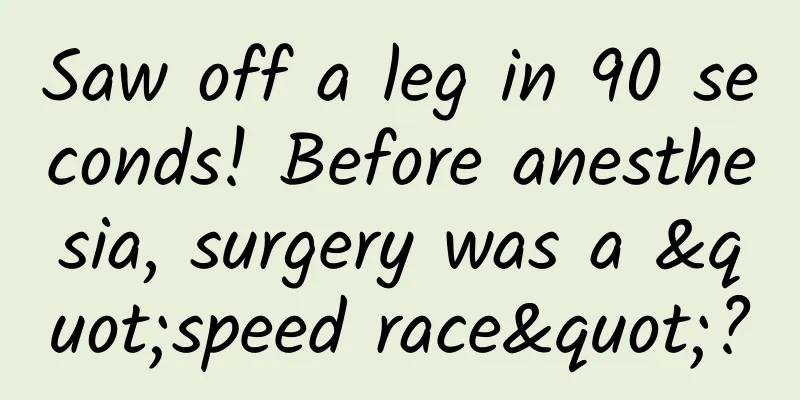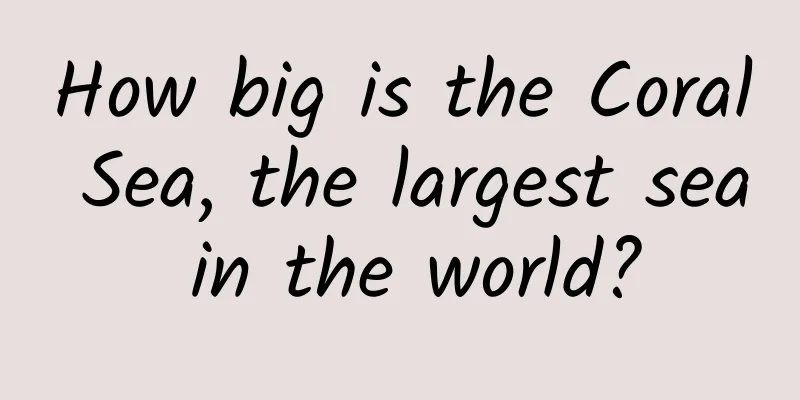Saw off a leg in 90 seconds! Before anesthesia, surgery was a "speed race"?

|
Audit expert: Zhu Guangsi Member of Beijing Science Writers Association In 1846, in London, England, a patient was about to undergo an amputation. At this moment, he was lying on the operating table and watching the doctor. There were two assistants beside the doctor, ready to hold the patient down to prevent him from struggling violently. However, the doctor today did not intend to give any instructions. Instead, he connected a rubber tube to his mouth, and the other end of the rubber tube was connected to a flask of ether. He told the patient: From now on, you need to breathe through this rubber tube, and then went to get the scalpel. At this time, everyone was quiet, and the only sound in the room was the patient's rapid breathing. After only two or three minutes, the patient began to become quiet. The doctor took out the rubber tube from his mouth, put a handkerchief with a few drops of ether on his face, and then quickly started the operation. After only 28 seconds, the patient's leg was successfully sawed off. After a few minutes, the patient woke up from his coma and murmured: Why don't you start? Let me go home. The people around him couldn't help but start laughing. The excited doctor loudly announced to everyone: "The American trick" was successful! Robert Liston Source: Wikipedia The doctor's name was Robert Liston, he was the most famous surgeon in Britain at that time. The operation he performed was also the first surgery in European history to be performed under ether anesthesia. What was surgery like before the invention of anesthesia? What unique contributions did doctors and people make in the invention of anesthesia? Let us open the scroll of history and show you a tortuous medical history. How to perform surgery without anesthesia? The earliest surgical operations were not as brutal and bloody as we imagine and imagine. In the 17th and 18th centuries, surgical operations were limited to a few types, such as bandaging wounds, puncturing abscesses, fixing fractures, and binding hernias. On the one hand, people’s average life expectancy was shorter at that time, and they would not suffer from diseases that were too complicated to require surgery; on the other hand, operations that took a long time or required extremely high precision were beyond the skills and level of early surgeons. Except for the last resort of caesarean sections, doctors generally would not choose to use surgery to save patients’ lives. However, with the invention of gunpowder, the emergence of new weapons changed the form of war and medical treatment: bullet and shell fragments often penetrate the human body, causing more serious trauma than in the cold weapon era, and a little carelessness can cause serious infection and complex systemic symptoms. Therefore, it is increasingly necessary to complete amputation as soon as possible while the wounded are still physically strong and their body functions are not greatly affected. In addition, with the development of industrialization, more and more industrial injuries and car accidents have begun to occur in cities. Many people have broken bones due to traffic accidents, and if their arms and feet are accidentally caught in running machines, they will also cause serious internal and external injuries. The increasingly urgent and complex conditions have made surgery gradually become a rational choice for doctors and patients. An 18th-century medical book describing amputation Source: Wikipedia In 1789, French military doctor Pare invented the "clamp hemostasis method", which gave surgeons an effective means of hemostasis. Patients no longer died from excessive blood loss, and surgery took the first step towards safety. However, intraoperative pain and postoperative infection still hindered the process of saving lives. Without anesthesia and disinfection, the surgical process retained more of the most primitive state of medicine: facing a bloody scene. The surgical operating room at that time was more like a concert hall. The operating table was placed in the center of a circular, soundproof theater, surrounded by layers of high platforms for spectators to stand on (this practice was very common in an era without the concept of disinfection). There was no shadowless lamp on the operating table, and no one wore masks or gloves. The most special thing was that there were often several special staff members in the operating room. Their job was not to deliver surgical equipment, but to help the doctor hold down the patient when the patient could not bear the pain, so that the operation could be completed smoothly. Early operating room source: Wiki Fanny Burney, one of the most famous novelists of the early 19th century, once underwent a mastectomy while awake. Despite the great pain she suffered, she was lucky enough to recover from the operation and still lived for 29 years, but she still shuddered whenever the memory was triggered. When the young doctor Keats graduated from medical school with a degree in surgery, he "had great ambitions to do something to change the world", but after undergoing several operations, he decisively gave up this risky and painful career and became a poet instead. Francis Burney (also known as Fanny Burney) English novelist Source: Wikipedia For patients of that era, once they had no choice but to choose surgery, they were undoubtedly half a step into the gates of hell. The only consolation was the speed of the doctor's surgery. Speedy surgery not only shortened the pain time, but also reduced the chance of infection. The quality of surgical operations in that era depended largely on the surgeon's agility, the sharpness of the blade, and the calmness of his demeanor. Only in this way could the pain be effectively reduced. Surgeons at the time, like athletes today, were committed to breaking records for time and speed in surgery. In 1824, a doctor named Astley Cooper took 20 minutes to amputate a leg at the hip joint; ten years later, James Syme (1799-1870) did it in just 90 seconds. Image of a soldier injured and amputated during the American Civil War Source: Wikipedia French doctor Dominique J. Larrey once set a record of completing 200 operations in 24 hours during the Battle of Borodino, completing an amputation every seven minutes on average. However, the reason why he is famous in medical history is not because of his speed as some articles claim, but because he first created a horse-drawn carriage for emergency treatment and triage rescue on the battlefield. In addition, it cannot be ignored that despite his high speed, the mortality rate of the operation was still as high as 50% due to limited conditions. Shortening the operation time is obviously not the solution to the problem. If we blindly pursue speed, surgical operations will not be able to develop towards precision and complexity. The discovery of anesthesia: a history driven by “quasi-medical scientists” Faced with the pain of patients, surgical medicine urgently needed to change. Unfortunately, the surgical community at that time still adhered to the principle of fast surgery. A few doctors would try to use hypnosis and improve the herbal anesthesia that had been used for thousands of years, but most people's energy was still focused on refreshing the speed of surgery. However, there was still a group of people who were closely following the technological development of painless surgery. They were dentists who were on the fringe of orthodox medicine at that time. In the early 19th century, stomatology had just emerged and had not yet been widely recognized by the medical community, but the industry's pioneers were working hard to improve their social status and technical level. During this period, dental implant technology had made great progress, but if you wanted to have a dental implant, you often had to extract the tooth first. What does it mean to extract a tooth without anesthesia? I'm sure everyone can relate to this when recalling their own experience in treating tooth decay. An 18th century denture Source: Wikipedia The negative attitude of patients who would rather endure the torture of rotten teeth than undergo tooth extraction surgery hindered the development of the entire industry and brought real survival pressure to dentists. Dentists of that era had a strong interest in any substances and methods that could eliminate pain. This was a time of great chemical development. The inspiration for dentists came from the byproduct of this development, the gas show. Since the discovery of oxygen, people have become increasingly curious about various "special airs" that look the same as air but have very different properties. In 1844, an American named Gardner Quincy Colton, who called himself a "chemistry professor," performed a gas show at Harvard University. A local dentist, Horace Wells, was among the audience. Wells was an expert in denture making and a dentist who was also keen on finding ways to eliminate pain. During the performance, a volunteer who was jumping around accidentally hit his calf. After returning to his seat, Wells asked him how his leg was: surprisingly, although the injury was serious, the man replied that he didn't feel anything. Wells immediately realized that the inhaled gas dulled the pain. After asking Colton the name of the gas, he got the answer: the gas was laughing gas. Space-filling model of the nitrous oxide (laughing gas) molecule Source: Wikipedia After the performance, Dr. Wells persuaded Colton to bring the device to his residence. The next morning, Colton gave Wells the laughing gas, and then a dental student pulled a tooth on the spot. When Wells woke up, he was surprised to find that he did not feel any pain. In the next few days, he successfully extracted teeth for 15 patients with the help of laughing gas. Horace Wells, pioneer of modern anesthesiology Source: Wikipedia Encouraged by his success, Dr. Wells decided to make further efforts and contacted Harvard Medical School to demonstrate this painless technology in public. However, it was not so easy to get the mainstream medical community to accept this new method. On the day of Dr. Wells' public demonstration, the surgeon who made the opening introduction, Professor John Collins Warren of Harvard Medical School, clearly expressed his doubts: "This gentleman, he claims to have something that can eliminate surgical pain." The professor's attitude immediately made Wells nervous. Unfortunately, the patient who was scheduled to be publicly demonstrated refused the operation temporarily. Although a male student at the scene volunteered to ask Wells to extract his teeth, he still became agitated and groaned during the operation. The demonstration failed, the audience laughed, and some hostile people even said "this is just a charlatan's trick". Amid the ridicule, Wells left in embarrassment and never demonstrated his anesthesia method publicly again. Also in the audience was another dentist, William T. G. Morton, who would soon become involved in research on anesthetic gases. William Morton Source: Wikipedia Like Wells, Morton was also an excellent denture designer. He had been committed to the search for anesthetic drugs, but he chose another gas that was often used for pleasure at the time - ether. Compared with Wells, Morton was more cautious. Before testing the effect on patients, he decided to try it on items at home. He used ether to test the puppy at home and the goldfish raised by his wife. After getting positive results, he decided to carry out the experiment to the end: covering his face with a piece of cloth soaked in ether. An overdose of ether could be life-threatening, but fortunately, after he lost consciousness, the cloth fell off his face. After a long 8 minutes, Morton finally woke up, and this heart-wrenching self-experiment finally came to an end. Ether molecular structure model Source: Wikipedia After waking up, Morton began to work on making a device to effectively control the amount of ether inhaled. On October 16, 1846, under the arrangement of Dr. Henry Bigelow of Massachusetts General Hospital, Morton once again made a public demonstration to doctors and audiences: a butler named Gilbert Abbott needed to undergo a resection surgery because of a hemangioma in his neck. The surgeon was still Professor John Warren, and Dr. Morton needed to provide anesthesia technology during the process. On the day of the operation, Dr. Morton was late and appeared very tired. The night before his first demonstration, he worked until late at night, constantly adjusting the ether inhaler that would be used the next day. Despite his hurried look, he calmed down and asked the patient, "Are you afraid?" "No, I will do as you tell me," the patient, who was tied to the chair, replied. So Dr. Morton pointed the ether inhaler at the patient, and soon he fell into a deep sleep. First use of ether Source: Wikipedia Now, the formal removal operation can be carried out. Every corner of the amphitheater was in a near-death silence. Everyone present was anxiously expecting, as if they could expect the patient's screams of pain when the scalpel pierced the sensitive nerves. But a few seconds later, people realized that such a terrifying scene did not happen. The operation was proceeding in an orderly manner according to the established steps: blood spurted from the severed artery, the patient sat there quietly, and the doctor was concentrating on his work... After 25 minutes, the tumor in the neck was successfully removed. Shocked by the effect of anesthesia, Dr. Warren excitedly announced to the audience: Gentlemen, this is not a scam! The news of the success of anesthesia began to spread around the world. Dr. Henry Bigelow, who introduced Morton to the Massachusetts General Hospital for demonstration, wrote a paper specifically for him and read it to his medical colleagues at the American Academy of Sciences and Arts on November 3, 1846. A writer named Holmes gave this new technology a formal name in his correspondence with Dr. Morton: Anesthesia. An means "nothing" in Greek, and esthesia means "perception", and the word "anesthesia" was thus determined. Children receiving anesthesia Source: Wikipedia 63 days after Dr. Morton's demonstration, a British dentist used ether anesthesia to extract a deep-seated molar. After learning the details of ether anesthesia, British surgeon Robert Liston performed the first anesthesia amputation in continental Europe, which is the scene described at the beginning of this article. The pain that has accompanied surgical operations for thousands of years has finally bid farewell to the stage of history. Under the protection of anesthesia, surgical operations have ended the barbaric era of blood and flesh flying everywhere and started a new journey of development. Conclusion If we re-examine this period of history, it is not difficult to find that it is a journey full of twists and turns and luck. To be honest, any medical progress relies on evidence. If medical colleagues are required to step out of their academic comfort zone or break the existing medical consensus, they almost always need well-designed and well-executed clinical trials. Although the two doctors in the article actively explored and showed extraordinary courage in their own experiments, such attempts were still crude, so it was natural that their pioneering work was questioned by their peers. Fortunately, they finally succeeded, and with the joint efforts of doctors, anesthesia spread throughout the world. Monument commemorating the first use of ether in anesthesia Source: Wikipedia Sadly, Dr. Morton was embroiled in an endless battle to protect his invention from the moment it was publicly displayed, wasting his time and fortune without gaining anything. Fortunately, when all the disputes are over, we can still remember what he and other pioneers did for the advancement of medicine. As Dr. Morton's epitaph says: Before him, surgery was painful; after him, science conquered pain. |
<<: Many Nobel Prizes are actually related to it! Do you consume enough every day?
Recommend
Comparison of the five major smartphone systems to see which one is stronger
Smartphones are mobile phones with more powerful ...
Feng Shui selection and layout of shops (Jiang Wenhe)
Jiang Wenhe's "Shop Feng Shui Selection ...
What are the “menstrual-like” hot spots in Beijing, Shanghai and Guangzhou?
In this article, Li Jiaoshou analyzes: After chan...
The cost of acquiring customers is getting higher and higher. How to build a complete user operation system?
How to do user operations ? In fact, most colleag...
Analyst: China's business has become a burden for Apple
A new year brings new prospects, and so does Appl...
Smartisan T2 review: Still unique, but not as nostalgic
No one would have expected that the battle in the...
Shocked! Eating, drinking and having fun can actually cause this disease?
Recently, the Eyelid and Orbital Disease/Ocular P...
Understand "How to apply for Xiaomi's first release for APP" in 3 minutes
This article is also known as " Xiaomi App S...
International Consumer Rights Day丨“Free XX”, is it really free?
China Consumers Association The results of the 20...
What should Baidu Wenku do? What are the tips for uploading to Baidu Wenku?
With the continuous development of the Internet, ...
Who will win the smart fitness market, Google or Apple?
The Apple Watch is coming on strong. The battlefi...
Selling one app in two parts, this is Google's new strategy
[[133445]] For mobile software developers, softwa...
JSPatch deployment security policy
There are two security issues with using JSPatch:...
Path, Google+ and Bullet Messenger: No. 2 in social products is meaningless
[[247055]] Image source: Visual China On October ...









